Synthesis of Potential Antiviral Agents for SARS-CoV-2 Using Molecular Hybridization Approach
Abstract
:1. Introduction
2. Results and Discussion
2.1. HPLC-MS Analysis
2.2. Antiviral Studies
2.3. Docking Studies
2.4. Absorption, Distribution, Metabolism, and Excretion (ADME) Studies
3. Conclusions
4. Experimental Section
4.1. General Procedure for the Synthesis of Building Block A
4.2. General Procedure for the Synthesis of Building Block B
4.3. General Procedure for the Synthesis of Molecular Hybrid Conjugates 9a–k and 10a,b
4.4. HPLC-MS Conditions
4.5. Biological Data
4.5.1. MTT Cytotoxicity Assay
4.5.2. IC50 Determination
Supplementary Materials
Author Contributions
Funding
Institutional Review Board Statement
Informed Consent Statement
Data Availability Statement
Acknowledgments
Conflicts of Interest
Sample Availability
References
- COVID Variants: What You Should Know. Available online: https://www.hopkinsmedicine.org/health/conditions-and-diseases/coronavirus/a-new-strain-of-coronavirus-what-you-should-know (accessed on 31 July 2022).
- Priyadarshini, I.; Mohanty, P.; Kumar, R.; Son, L.H.; Chau, H.T.M.; Nhu, V.-H.; Thi Ngo, P.T.; Tien Bui, D. Analysis of Outbreak and Global Impacts of the SARS-CoV-2. Available online: https://www.mdpi.com/2227-9032/8/2/148/htm (accessed on 31 July 2022).
- Al-Karmalawy, A.A.; Soltane, R.; Elmaaty, A.A.; Tantawy, M.A.; Antar, S.A.; Yahya, G.; Chrouda, A.; Pashameah, R.A.; Mustafa, M.; Abu Mraheil, M.; et al. Coronavirus Disease (COVID-19) Control between Drug Repurposing and Vaccination: A Comprehensive Overview. Vaccines 2021, 9, 1317. [Google Scholar] [CrossRef] [PubMed]
- SARS-CoV-2 Drugs: Are There Any That Work? Available online: https://www.mayoclinic.org/diseases-conditions/coronavirus/expert-answers/coronavirus-drugs/faq-20485627 (accessed on 31 July 2022).
- Veklury® (Remdesivir) Mechanism of Action. Available online: https://www.vekluryhcp.com/about/about-moa.php (accessed on 31 July 2022).
- Zhang, B. Comprehensive review on the anti-bacterial activity of 1,2,3-triazole hybrids. Eur. J. Med. Chem. 2019, 168, 357–372. [Google Scholar] [CrossRef] [PubMed]
- Kim, D.-K.; Kim, J.; Park, H.-J. Synthesis and biological evaluation of novel 2-pyridinyl-[1,2,3]triazoles as inhibitors of transforming growth factor β1 type 1 receptor. Bioorganic Med. Chem. Lett. 2004, 14, 2401–2405. [Google Scholar] [CrossRef] [PubMed]
- Whiting, M.; Tripp, J.C.; Lin, Y.-C.; Lindstrom, W.; Olson, A.J.; Elder, J.H.; Sharpless, K.B.; Fokin, V.V. Rapid discovery and structure-activity profiling of novel inhibitors of human immunodeficiency virus type 1 protease enabled by the copper(I)-catalyzed synthesis of 1,2,3-triazoles and their further functionalization. J. Med. Chem. 2006, 49, 7697–7710. [Google Scholar] [CrossRef] [PubMed]
- Cheng, Z.-Y.; Li, W.-J.; He, F.; Zhou, J.-M.; Zhu, X.-F. Synthesis and biological evaluation of 4-aryl-5-cyano-2H-1,2,3-triazoles as inhibitor of HER2 tyrosine kinase. Bioorganic Med. Chem. 2007, 15, 1533–1538. [Google Scholar] [CrossRef]
- da Silva, F.d.C.; de Souza, M.C.B.V.; Frugulhetti, I.I.P.; Castro, H.C.; Souza, S.L.d.O.; de Souza, T.M.L.; Rodrigues, D.Q.; Souza, A.M.T.; Abreu, P.A.; Passamani, F.; et al. Synthesis, HIV-RT inhibitory activity and SAR of 1-benzyl-1H-1,2,3-triazole derivatives of carbohydrates. Eur. J. Med. Chem. 2009, 44, 373–383. [Google Scholar] [CrossRef] [PubMed]
- Meanwell, N.A. Fluorine and Fluorinated Motifs in the Design and Application of Bioisosteres for Drug Design. J. Med. Chem. 2018, 61, 5822–5880. [Google Scholar] [CrossRef]
- Britannica, T. Editors of Encyclopedia. Indole, Encyclopedia Britannica. Available online: https://www.britannica.com/science/indole (accessed on 3 August 2022).
- Zhang, M.-Z.; Chen, Q.; Yang, G.-F. A review on recent developments of indole-containing antiviral agents. Eur. J. Med. Chem. 2015, 89, 421–441. [Google Scholar] [CrossRef]
- Katritzky, A.R.; Tala, S.R.; Lu, H.; Vakulenko, A.V.; Chen, Q.-Y.; Sivapackiam, J.; Pandya, K.; Jiang, S.; Debnath, A.K. Design, Synthesis, and Structure−Activity Relationship of a Novel Series of 2-Aryl 5-(4-Oxo-3-phenethyl-2-thioxothiazolidinylidenemethyl)furans as HIV-1 Entry Inhibitors. J. Med. Chem. 2009, 52, 7631–7639. [Google Scholar] [CrossRef]
- Curreli, F.; Ahmed, S.; Victor, S.M.B.; Drelich, A.; Panda, S.S.; Altieri, A.; Kurkin, A.V.; Tseng, C.-T.K.; Hillyer, C.D.; Debnath, A.K. Discovery of Highly Potent Fusion Inhibitors with Potential Pan-Coronavirus Activity That Effectively Inhibit Major COVID-19 Variants of Concern (VOCs) in Pseudovirus-Based Assays. Viruses 2021, 14, 69. [Google Scholar] [CrossRef]
- Maga, G.; Falchi, F.; Radi, M.; Botta, L.; Casaluce, G.; Bernardini, M.; Irannejad, H.; Manetti, F.; Garbelli, A.; Samuele, A.; et al. Toward the Discovery of Novel Anti-HIV Drugs. Second-Generation Inhibitors of the Cellular ATPase DDX3 with Improved Anti-HIV Activity: Synthesis, Structure-Activity Relationship Analysis, Cytotoxicity Studies, and Target Validation. ChemMedChem 2011, 6, 1371–1389. [Google Scholar] [CrossRef]
- da Silva, E.T.; de Andrade, G.F.; Araújo, A.D.S.; Lourenço, M.C.S.; de Souza, M.V.N. Antibacterial activity of new substituted 4-N-alkylated-2-trifluoromethyl-quinoline analogues against sensitive and resistant Mycobacterium tuberculosis strains. Eur. J. Pharm. Sci. 2021, 157, 105596. [Google Scholar] [CrossRef] [PubMed]
- Maračić, S.; Lapić, J.; Djaković, S.; Opačak-Bernardi, T.; Glavaš-Obrovac, L.; Vrček, V.; Raić-Malić, S. Quinoline and ferrocene conjugates: Synthesis, computational study and biological evaluations. Appl. Organomet. Chem. 2019, 33, e4628. [Google Scholar] [CrossRef]
- Panda, S.S.; Jain, S.C. New trifluoromethyl quinolone derivatives: Synthesis and investigation of antimicrobial properties. Bioorganic Med. Chem. Lett. 2013, 23, 3225–3229. [Google Scholar] [CrossRef]
- Ghanim, A.M.; Girgis, A.S.; Kariuki, B.M.; Samir, N.; Said, M.F.; Abdelnaser, A.; Nasr, S.; Bekheit, M.S.; Abdelhameed, M.F.; Almalki, A.J.; et al. Design and synthesis of ibuprofen-quinoline conjugates as potential anti-inflammatory and analgesic drug candidates. Bioorganic Chem. 2022, 119, 105557. [Google Scholar] [CrossRef]
- Feoktistova, M.; Geserick, P.; Leverkus, M. Crystal Violet Assay for Determining Viability of Cultured Cells; Cold Spring Harbor Laboratory Press: Long Island, NY, USA, 2016. [Google Scholar] [CrossRef]
- Srour, A.M.; Panda, S.S.; Mostafa, A.; Fayad, W.; El-Manawaty, M.A.; Soliman, A.A.F.; Moatasim, Y.; El Taweel, A.; Abdelhameed, M.F.; Bekheit, M.S.; et al. Synthesis of aspirin-curcumin mimic conjugates of potential antitumor and anti-SARS-CoV-2 properties. Bioorganic Chem. 2021, 117, 105466. [Google Scholar] [CrossRef] [PubMed]
- Girgis, A.S.; Panda, S.S.; Srour, A.M.; Abdelnaser, A.; Nasr, S.; Moatasim, Y.; Kutkat, O.; El Taweel, A.; Kandeil, A.; Mostafa, A.; et al. 3-Alkenyl-2-oxindoles: Synthesis, antiproliferative and antiviral properties against SARS-CoV-2. Bioorganic Chem. 2021, 114, 105131. [Google Scholar] [CrossRef] [PubMed]
- Seliem, I.A.; Panda, S.S.; Girgis, A.S.; Moatasim, Y.; Kandeil, A.; Mostafa, A.; Ali, M.A.; Nossier, E.S.; Rasslan, F.; Srour, A.M.; et al. New quinoline-triazole conjugates: Synthesis, and antiviral properties against SARS-CoV-2. Bioorganic Chem. 2021, 114, 105117. [Google Scholar] [CrossRef]
- Available online: http://www.rcsb.org/structure/6LU7 (accessed on 15 August 2022).
- Jin, Z.; Du, X.; Xu, Y.; Deng, Y.; Liu, M.; Zhao, Y.; Zhang, B.; Li, X.; Zhang, L.; Peng, C.; et al. Structure of Mpro from SARS-CoV-2 and discovery of its inhibitors. Nature 2020, 582, 289–293. [Google Scholar] [CrossRef] [Green Version]
- Tan, Y.L.; Tan, K.S.W.; Chu, J.J.H.; Chow, V.T. Combination Treatment with Remdesivir and Ivermectin Exerts Highly Synergistic and Potent Antiviral Activity against Murine Coronavirus Infection. Front. Cell. Infect. Microbiol. 2021, 11, 700502. [Google Scholar] [CrossRef]
- Girgis, A.S.; Panda, S.S.; Farag, I.S.A.; El-Shabiny, A.M.; Moustafa, A.M.; Ismail, N.S.M.; Pillai, G.G.; Panda, C.S.; Hall, C.D.; Katritzky, A.R. Synthesis, and QSAR analysis of anti-oncological active spiro-alkaloids. Org. Biomol. Chem. 2015, 13, 1741–1753. [Google Scholar] [CrossRef]
- Girgis, A.S.; Panda, S.S.; Srour, A.M.; Farag, H.; Ismail, N.S.M.; Elgendy, M.; Abdel-Aziz, A.K.; Katritzky, A.R. Rational design, synthesis and molecular modeling studies of novel anti-oncological alkaloids against melanoma. Org. Biomol. Chem. 2015, 13, 6619–6633. [Google Scholar] [CrossRef] [PubMed]
- Seliem, I.A.; Girgis, A.S.; Moatasim, Y.; Kandeil, A.; Mostafa, A.; Ali, M.A.; Bekheit, M.S.; Panda, S.S. New Pyrazine Conjugates: Synthesis, Computational Studies, and Antiviral Properties against SARS-CoV-2. ChemMedChem 2021, 16, 3418–3427. [Google Scholar] [CrossRef] [PubMed]
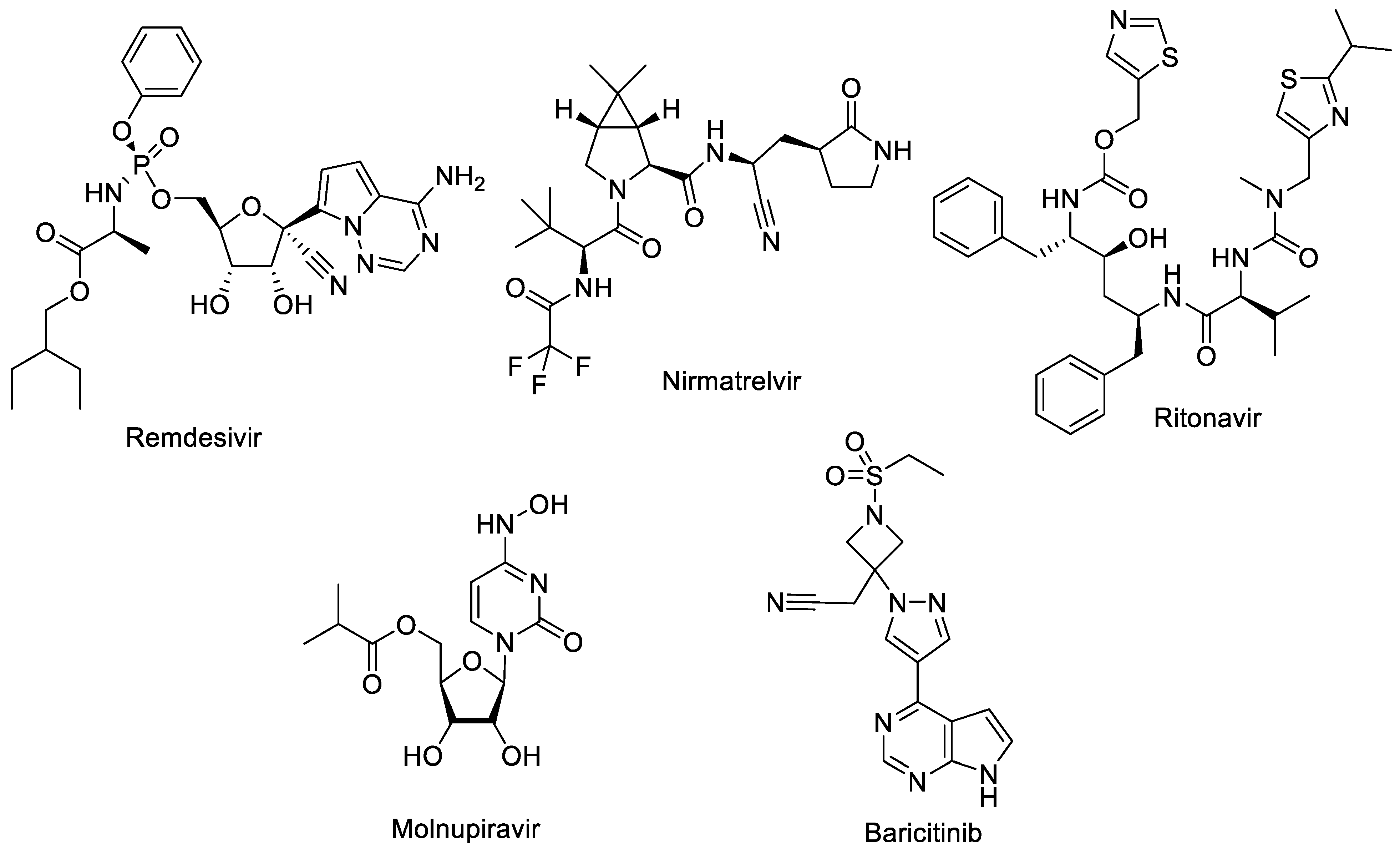
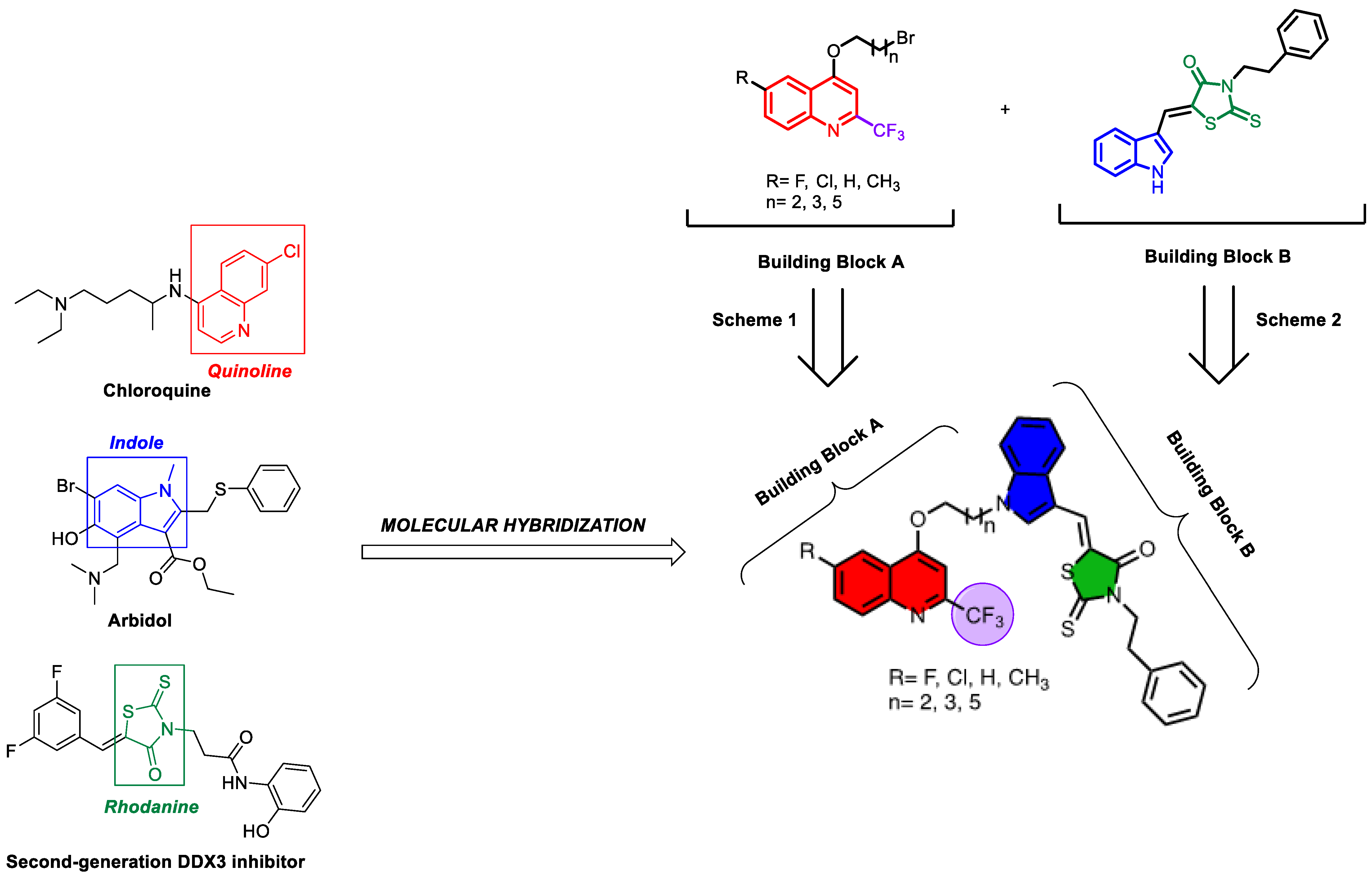
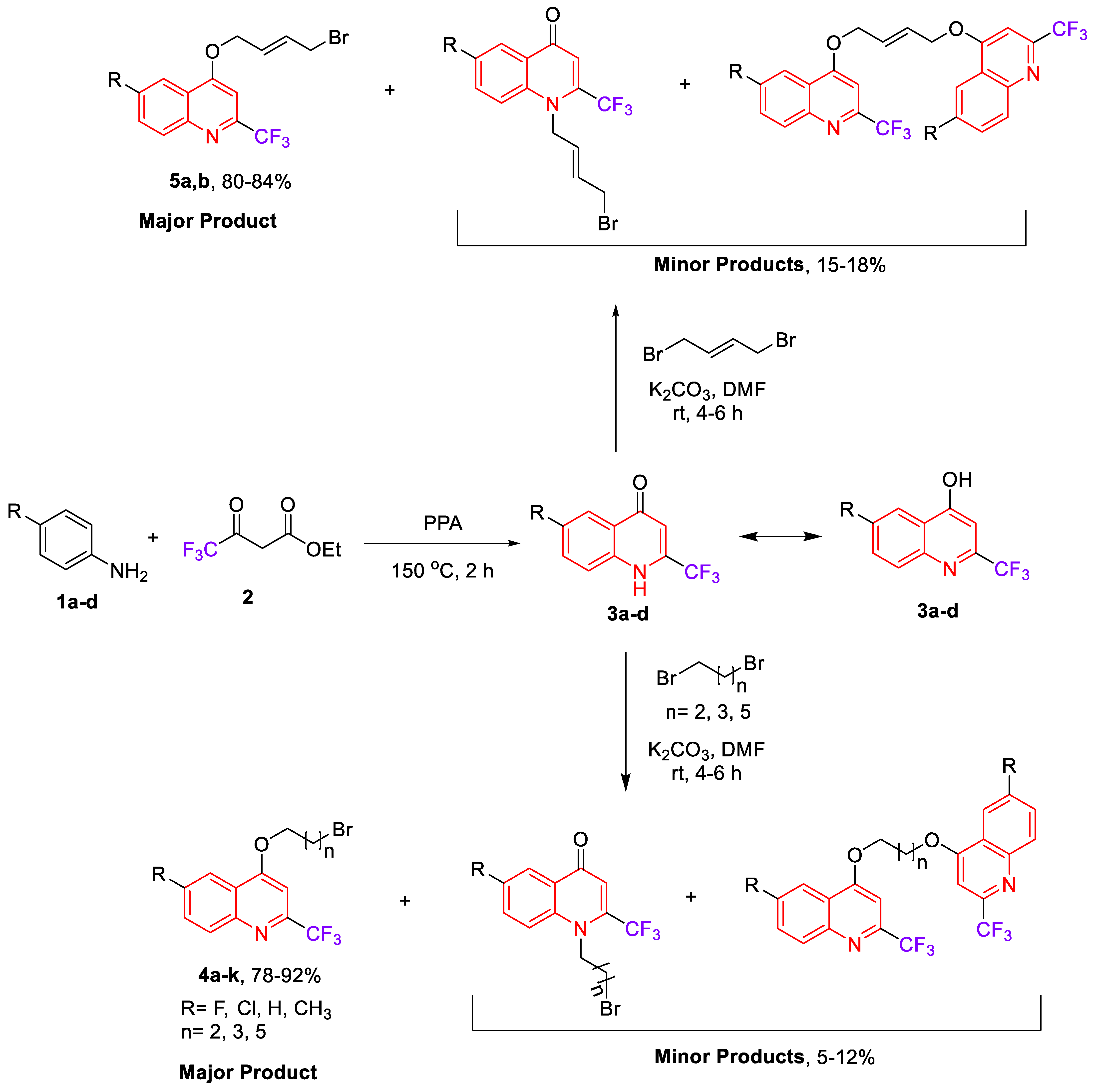

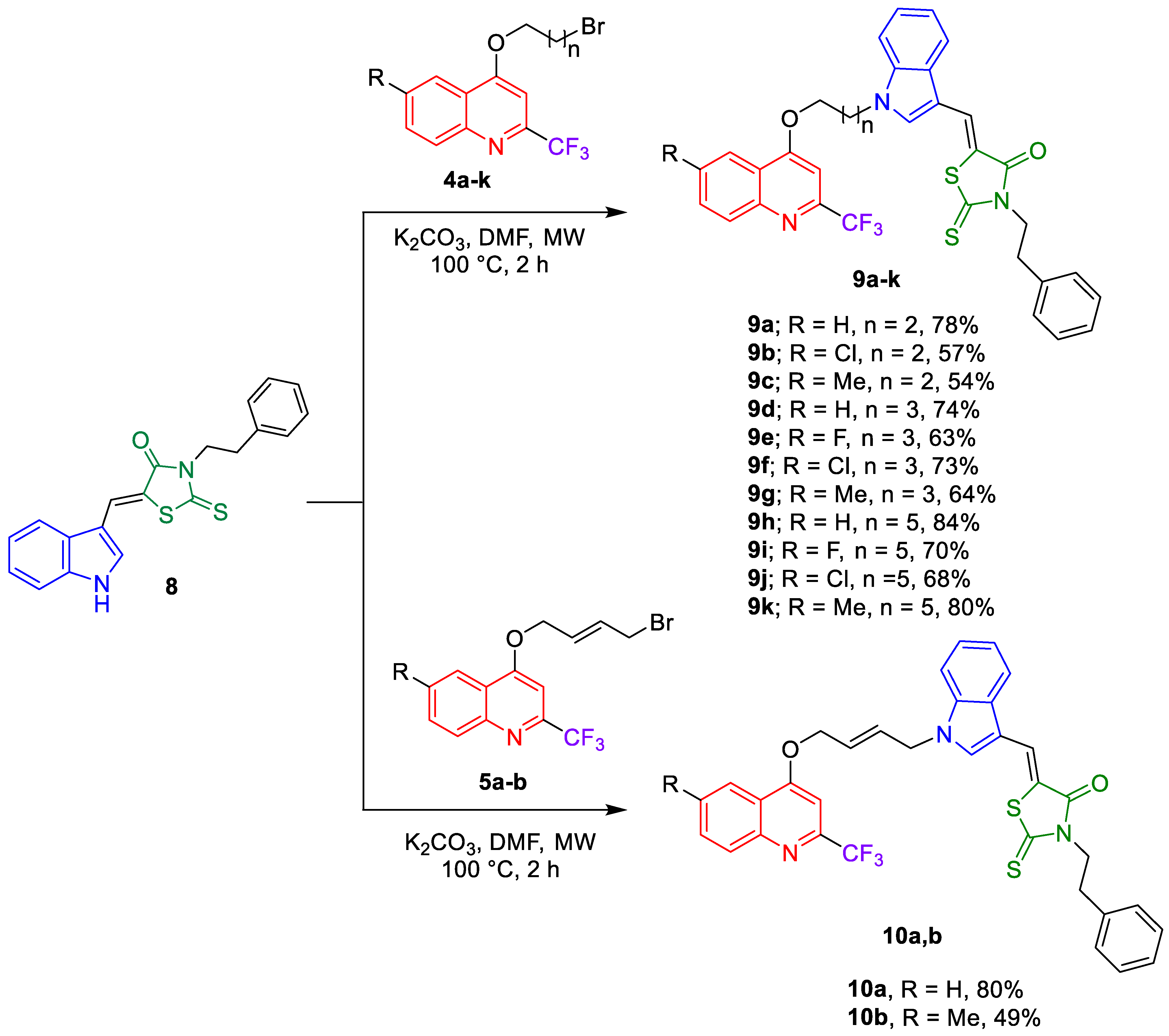
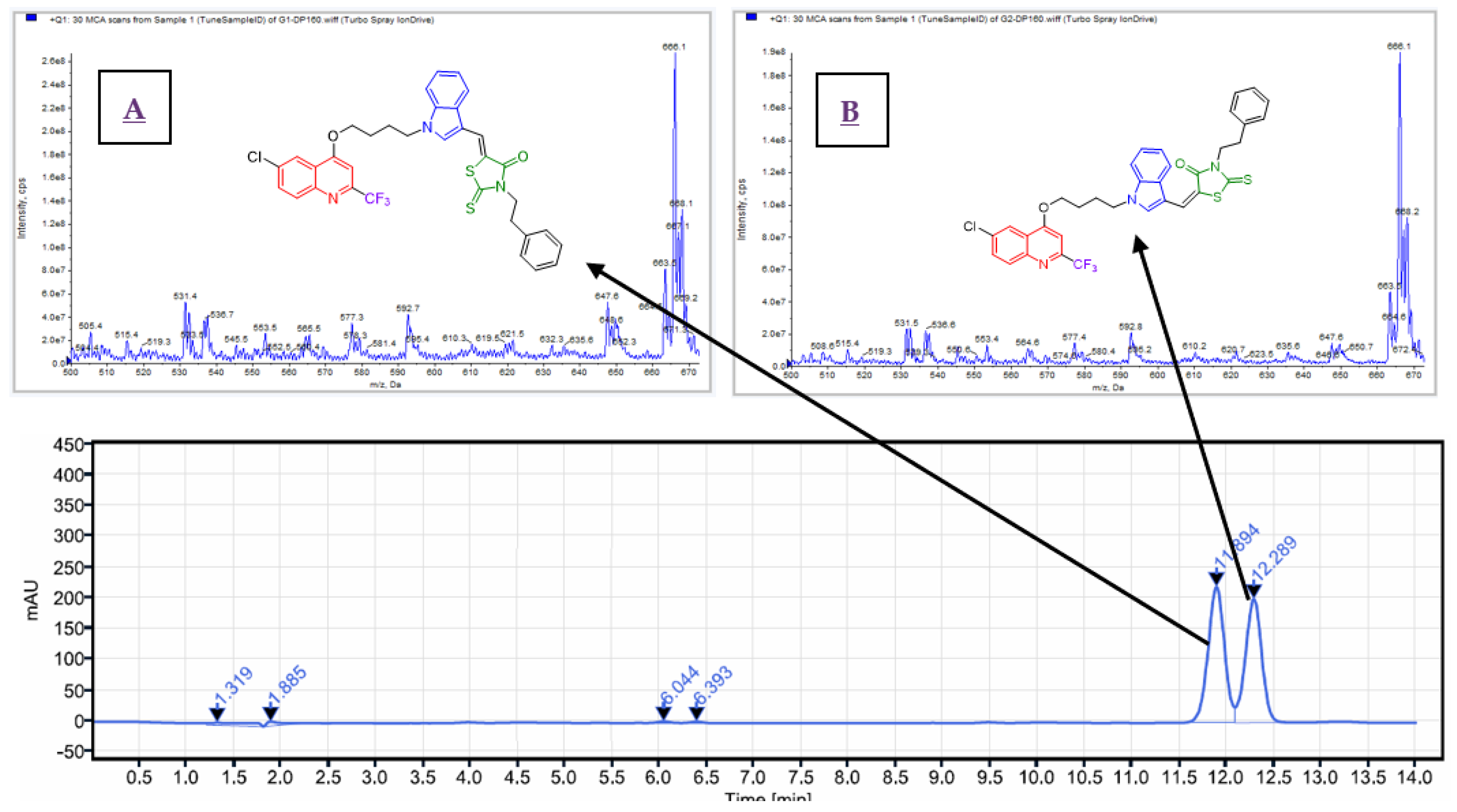
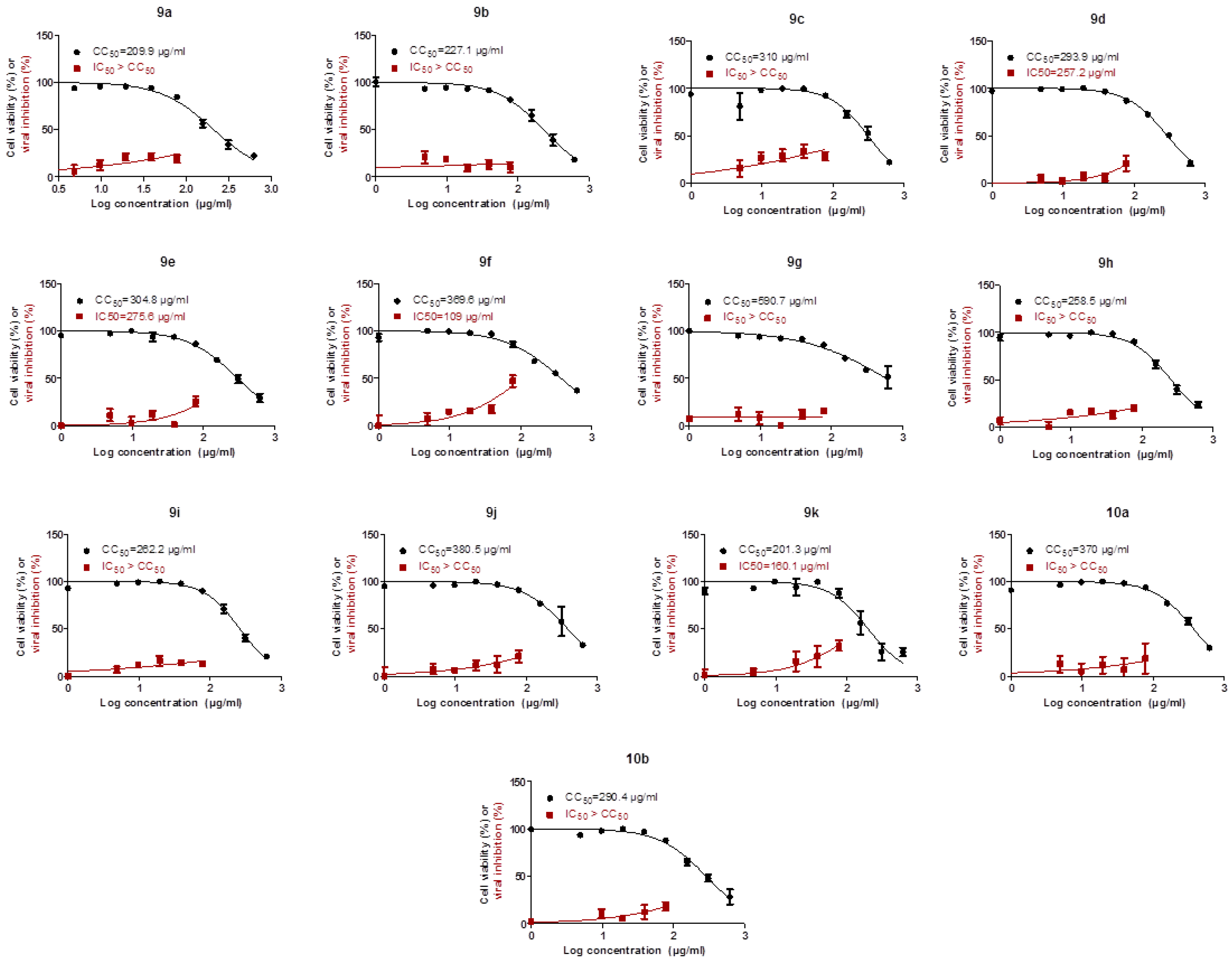
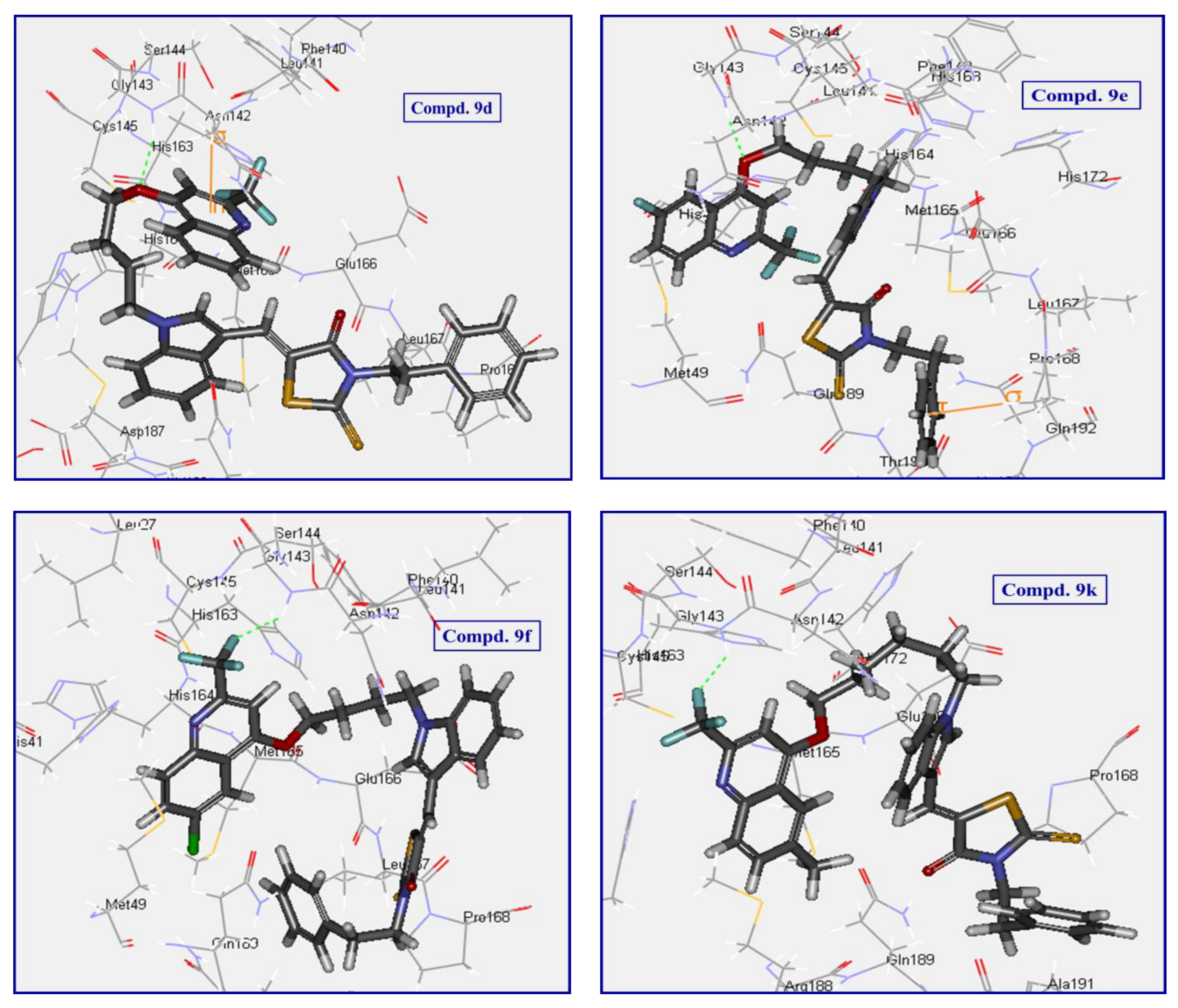
| Entry | Compd. | IC50, µg/mL (µM) | CC50, µg/mL (µM) | SI |
|---|---|---|---|---|
| 1 | 9d | 257.2 (407.1) | 293.9 (465.2) | 1.1 |
| 2 | 9e | 275.6 (424.2) | 304.8 (469.1) | 1.1 |
| 3 | 9f | 109.0 (163.6) | 369.6 (554.8) | 3.4 |
| 4 | 9k | 160.1 (237.6) | 201.3 (298.7) | 1.3 |
| 5 | Hydroxychloroquine [22] | (29.25) | (356.4) | 12.2 |
| 6 | Remdesivir [27] a | (3.38) | (58.12) | 17.18 |
| Entry | Compd. | Hydrogen Bonding Interactions | CDOCKER Interaction Energy Scores (Kcal mol−1) |
|---|---|---|---|
| 1 | 9d | Hydrogen bonding: quinolinyl O–GLY143, π–σ interactions: quinoline–ASN142 | −50.9 |
| 2 | 9e | Hydrogen bonding: quinolinyl O–GLY143, π–σ interactions: phenyl–PRO168 | −49.4 |
| 3 | 9f | Hydrogen bonding: F of CF3–GLY143 | −51.8 |
| 4 | 9k | Hydrogen bonding: F of CF3–GLY143 | −50.7 |
| Entry | Compd. | Aqueous Solubility | Intestinal Absorption | PPB |
|---|---|---|---|---|
| 1 | 9d | 3 | 0 | 2 |
| 2 | 9e | 3 | 0 | 2 |
| 3 | 9f | 3 | 0 | 2 |
| 4 | 9k | 3 | 0 | 2 |
Publisher’s Note: MDPI stays neutral with regard to jurisdictional claims in published maps and institutional affiliations. |
© 2022 by the authors. Licensee MDPI, Basel, Switzerland. This article is an open access article distributed under the terms and conditions of the Creative Commons Attribution (CC BY) license (https://creativecommons.org/licenses/by/4.0/).
Share and Cite
Wyman, K.A.; Girgis, A.S.; Surapaneni, P.S.; Moore, J.M.; Abo Shama, N.M.; Mahmoud, S.H.; Mostafa, A.; Barghash, R.F.; Juan, Z.; Dobaria, R.D.; et al. Synthesis of Potential Antiviral Agents for SARS-CoV-2 Using Molecular Hybridization Approach. Molecules 2022, 27, 5923. https://doi.org/10.3390/molecules27185923
Wyman KA, Girgis AS, Surapaneni PS, Moore JM, Abo Shama NM, Mahmoud SH, Mostafa A, Barghash RF, Juan Z, Dobaria RD, et al. Synthesis of Potential Antiviral Agents for SARS-CoV-2 Using Molecular Hybridization Approach. Molecules. 2022; 27(18):5923. https://doi.org/10.3390/molecules27185923
Chicago/Turabian StyleWyman, Kailey A., Adel S. Girgis, Pragnakiran S. Surapaneni, Jade M. Moore, Noura M. Abo Shama, Sara H. Mahmoud, Ahmed Mostafa, Reham F. Barghash, Zou Juan, Radha D. Dobaria, and et al. 2022. "Synthesis of Potential Antiviral Agents for SARS-CoV-2 Using Molecular Hybridization Approach" Molecules 27, no. 18: 5923. https://doi.org/10.3390/molecules27185923
APA StyleWyman, K. A., Girgis, A. S., Surapaneni, P. S., Moore, J. M., Abo Shama, N. M., Mahmoud, S. H., Mostafa, A., Barghash, R. F., Juan, Z., Dobaria, R. D., Almalki, A. J., Ibrahim, T. S., & Panda, S. S. (2022). Synthesis of Potential Antiviral Agents for SARS-CoV-2 Using Molecular Hybridization Approach. Molecules, 27(18), 5923. https://doi.org/10.3390/molecules27185923








